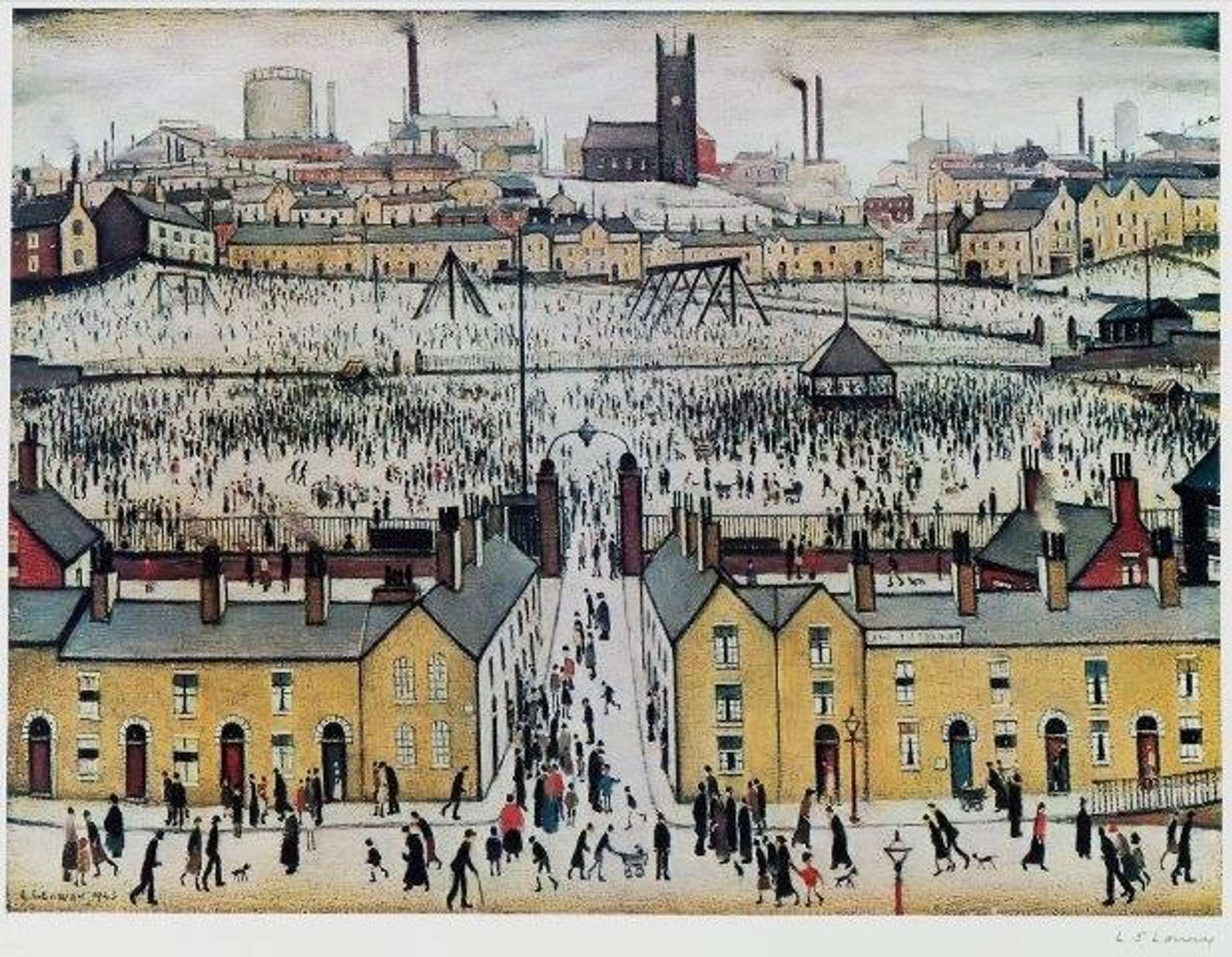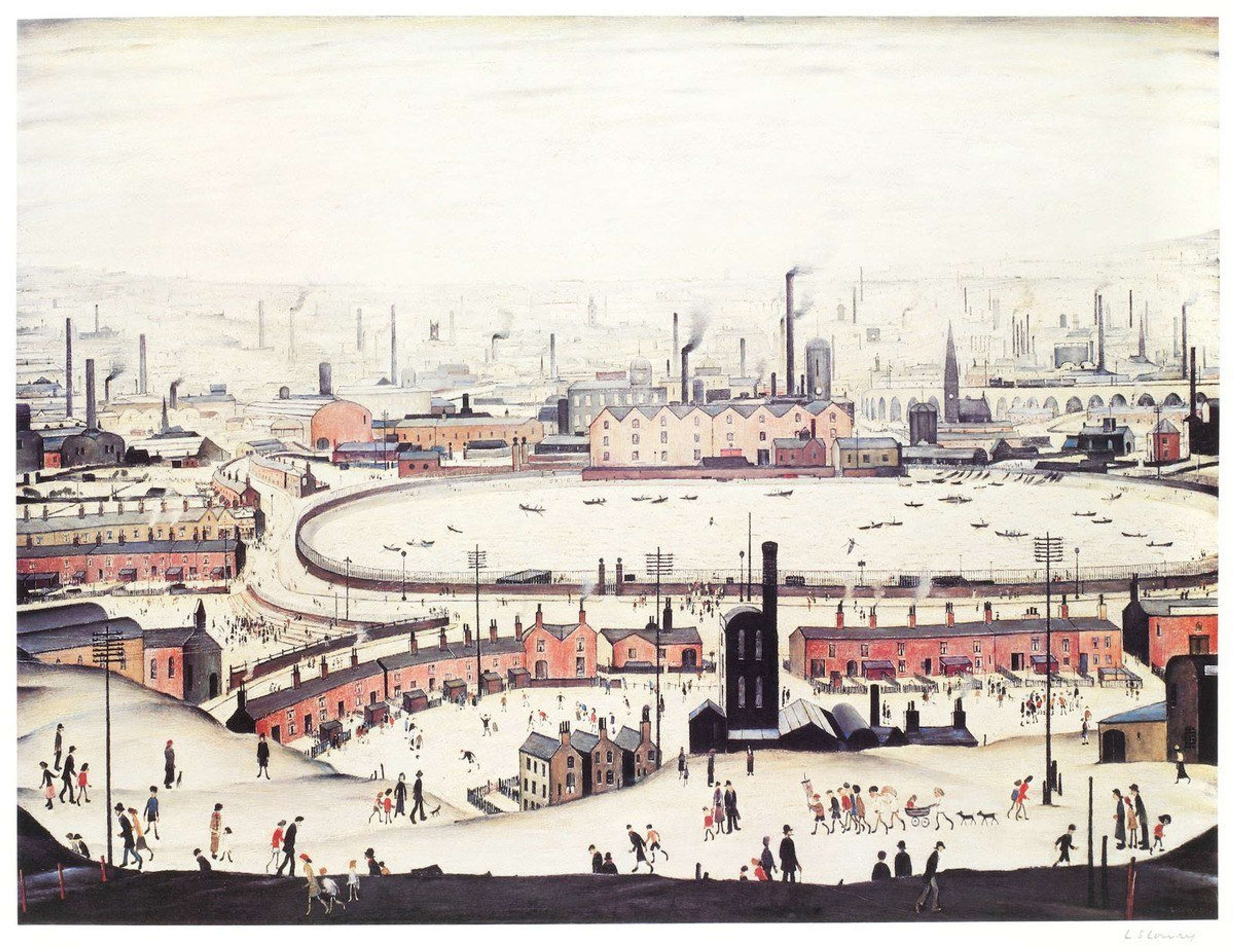The Beautiful Game: A Guide To Lowry’s Football Matches
 Going To The Match © L S Lowry 1972
Going To The Match © L S Lowry 1972
L S Lowry
73 works
The football paintings and prints of L S Lowry are among his most popular works, admired by football fans and Lowry collectors alike. Here are 10 quick facts about his best-known football artworks, including the record-breaking The Football Match and Going to the Match.
Lowry was a lifelong fan of Manchester City Football Club but he also created artworks about other teams
The artist had a soft spot for rival team Bolton Wanderers Football Club, as his home in Pendlebury was within walking distance of their former stadium at Burnden Park.
Manchester City vs. Sheffield United is one of Lowry’s earliest football paintings
Painted in 1938, it is a rare Lowry painting to depict a real event, rather than an imagined composite of different locations or events. The scene is thought to depict a Second Division game between the two clubs on 22 October 1938, in which Man City won.
The painting was offered at Christie’s in June 2008 but failed to secure a high enough bid. Within an hour of the sale ending, however, a private buyer approached the auction house and purchased the work.
Lowry’s football paintings captured the everyday lives of Mancunians
From crowds gathering for a big match to casual kickabouts between local children – like the scene depicted in Saturday Afternoon, 1941 – Lowry’s football pictures are as much a record of daily life in Greater Manchester as his industrial landscapes.
Some of his football paintings are now also a document of lost places. For example, Going To The Match records Bolton Wanderers’ old stadium at Burnden Park. The site was demolished in 1999, two years after the football club moved to their new grounds.
The Football Match, 1949, is the most expensive Lowry artwork at auction
The painting was originally bought for just £250 in 1951. It was first auctioned at Sotheby’s in 1992 for £132,000. After nearly 20 years hidden in the same private collection, The Football Match was offered at Christie’s in London in May 2011, where it achieved a record-breaking £5.6 million. Later, Going to the Match (1953) beat its own record, selling for £ 7,846,500 (including fees) at auction with Christie's in October 2022. The scene is depicted in Lowry’s signature birds-eye view panoramic, showing not only the football game but also smoking chimneys – perhaps the artist’s other most iconic motif.
Interested in the performance of L.S. Lowry’s art in 2023? Check out our latest Modern British Prints Market Report for market analysis of Lowry alongside other renowned British artists.
It is almost impossible to see the football in Lowry’s football paintings
Despite his love of the beautiful game, Lowry rarely depicted the action of a football match. Many of his football paintings show people going to the stadium. Others are a birds-eye view of the pitch, with the players sometimes no larger than a few brushstrokes. For the most part, Lowry’s football paintings portray the atmosphere or anticipation of games, rather than the action and players of matches.
Lowry sometimes made sketches at football games
Lowry was known to sketch on whatever he had in his pocket at the time, including scraps of paper, note cards and even the back of his bank statements. He has made a pencil drawing of a football match from behind the goal net, which later became made into a limited lithograph titled A Football Match. Lowry also made a sketch of figures walking to see a Bolton Wanderers match at Burden Park, which he later turned into Going To The Match, 1953, now considered one of his most famous football paintings.
Going to the Match won the first Football And Fine Arts competition in 1953
The exhibition was organised by the Football Association and the Arts Council as part of the FA’s 90th anniversary celebrations. Over 1,700 entries flooded in and the judges came from the Tate, National Galleries, the Arts Council the Slade School of Art.
Lowry received £250 for Going to the Match as there were, in fact, four winners sharing the £1,000 prize for the Painting category. Another winning work was Mid-Week Practice at Stamford Bridge by Lawrence Toynbee.
The Professional Footballers’ Association called a Lowry football painting “our prized possession”
In 1999, the PFA set an auction record for a Lowry painting at the time when it won the bid for Going To The Match at Christie’s. The painting went for over four times its estimate but, even at £1.9 million, it was still a bargain compared to the prices paid for a Premier League player (in 2020, Chelsea Football Club purchased midfielder Kai Havertz for €81 million). Going to the Match “will be our prized possession,” stated Gordon Taylor, the Chief Executive of the PFA, adding, “it is quite simply the finest football painting ever.”
Going to the Match is Lowry’s most popular print
The painting is one of the most visited artworks at The Lowry, Salford, attracting football fans and art lovers alike. Its fame also makes it Lowry’s most expensive and sought-after print on the secondary market.
In 1972, Lowry released 300 limited-edition signed lithographs of Going To The Match. The highest price paid for the print was £25,000 in February 2020, setting a new auction record for a Lowry print. The previous record price for a Going To The Match print was £22,000 in 2015.
Read our L. S. Lowry Market Watch to discover Lowry's top 5 most investable prints.
Football was not the only sport that Lowry painted
Lowry was also inspired by horse racing and cricket matches. He has made one known depiction of a rugby game, Coming From The Match, showing a crowd of fans exiting a Rochdale Hornets rugby match. The rare work sold for over four times its low estimate when it was offered in Christie’s online auction in July 2020.







